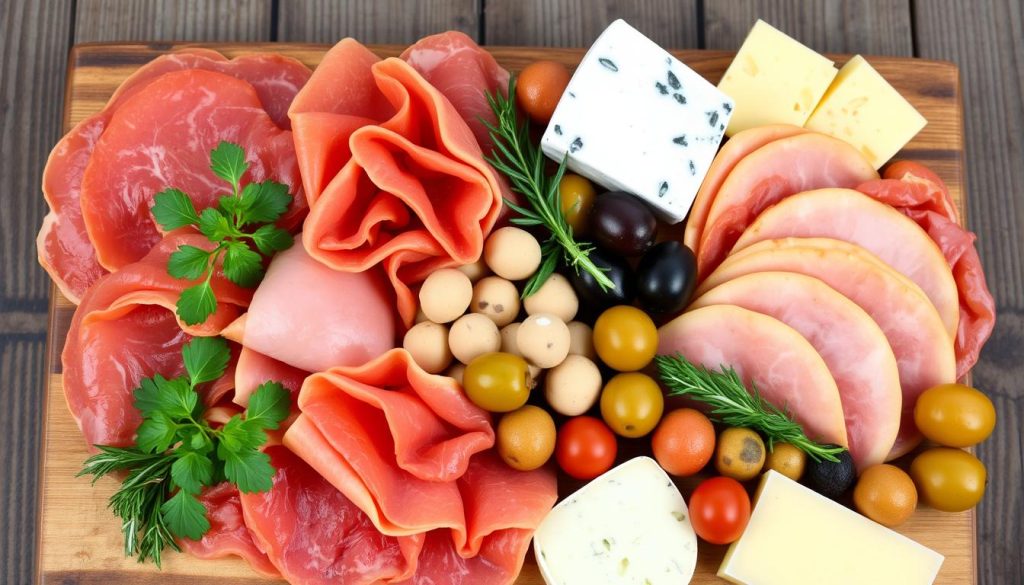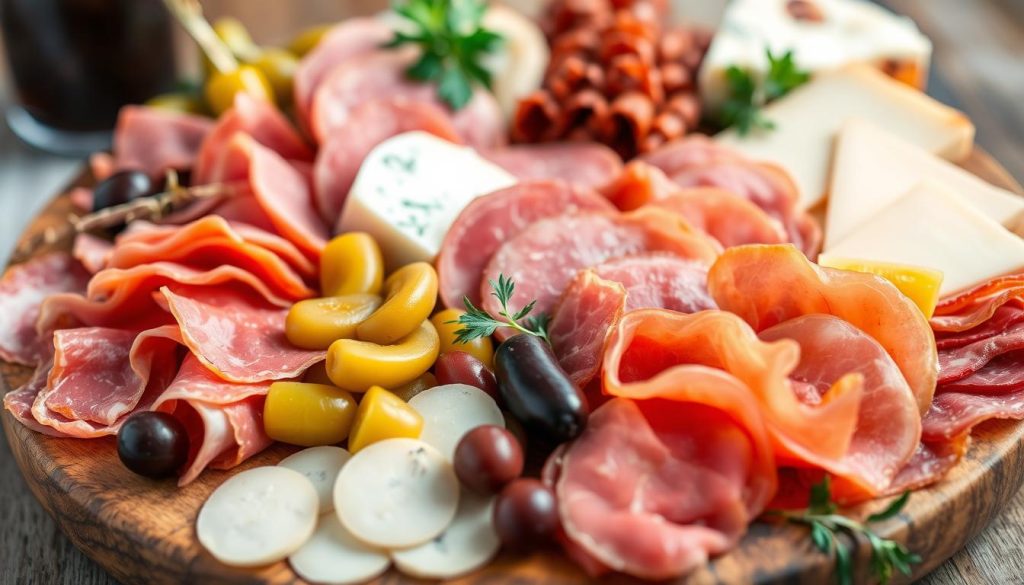Capicola is a tasty Italian cured meat that adds flavor and texture to many dishes. Sometimes, you might need a substitute for capicola. This could be because you’ve run out or you’re looking for options that fit different diets.
This guide will show you many capicola substitutes. You’ll learn how to make delicious meals without losing flavor. We’ll talk about traditional Italian meats and other protein sources. You’ll see how these substitutes can fit into your favorite recipes.
Enjoying great food shouldn’t be hard. We want to help you find substitutes that make your meals just as tasty. Let’s explore the world of capicola alternatives together and solve your cooking challenges.
Understanding Capicola and Its Flavor Profile
What is capicola? It’s a cured Italian meat, also called coppa. It comes from the pig’s neck and shoulder. First, the pork shoulder is marinated in a mix of salt, spices, and herbs.
After marinating, the meat is dry-cured. This step makes its flavors stronger over time.
The taste of capicola is rich and slightly spicy. The spiciness comes from chili peppers or red pepper flakes in the marinade. This adds a mild heat that enhances the flavor.
The curing mix also includes rosemary, thyme, and oregano. These give capicola its unique Italian taste.
During aging, capicola loses about 35% of its moisture. This makes it smoky. It’s smoked at low temperatures. The flavor can vary by region in Italy.
In the U.S., capicola flavors can differ. Some stick to traditional recipes, while others add new twists. It’s often used in Italian subs, charcuterie boards, salads, and omelettes.
| Aspect | Details |
|---|---|
| Cut of Meat | Pork shoulder, the “coppa” muscle |
| Spices Used | Salt, chili peppers, rosemary, thyme, oregano |
| Curing Time | Approximately one week |
| Texture | Chewy, with a 70/30 meat-to-fat ratio |
| Calories (2 oz) | 110 calories |
| Shelf Life (Refrigerator) | Approximately 5 days once opened |
| Freezing Duration | Up to 3 months, though texture may change |
What Can I Substitute for Capicola Guide
Capicola is a beloved Italian cured meat, loved for its taste and versatility. It’s used in many dishes. Knowing its uses and taste can help you find good substitutes. This part talks about capicola’s role in recipes and its unique taste.
Popular Uses for Capicola
Capicola is a hit with cooks and food lovers. It’s used in many ways, including:
- Layered on sandwiches, adding a savory touch.
- On antipasto platters, with olives and cheeses.
- In pasta dishes for extra flavor.
- In salads as a protein source.
- In breakfast foods like omelets and frittatas.
Flavor Characteristics of Capicola
Knowing capicola’s taste is key when looking for substitutes. It’s known for:
- Saltiness that boosts its flavor.
- A subtle sweetness that balances the salt.
- A hint of spice, from paprika and other seasonings.
These traits make capicola’s flavor complex and rich. In recipes, it adds depth and spice. When searching for substitutes, look for these qualities to find the best match.
| Flavor Profile Component | Description |
|---|---|
| Saltiness | Provides a robust flavor base that elevates other ingredients. |
| Sweetness | Creates a balanced taste, complementing savory items. |
| Spice | Offers a warm kick, often adjusted by the type of paprika used. |
Top Substitutes for Capicola
Looking for a good capicola substitute can really boost your cooking. Prosciutto, pancetta, and salami are top picks. Each brings its own taste and texture to your meals.
Prosciutto: The Delicate Ham
Prosciutto is known for its mild, sweet taste. It’s a dry-cured ham that’s air-dried for 9 to 18 months. You can swap it 1:1 for capicola in recipes.
It’s great with cheeses, fruits, and bread. This makes it perfect for sandwiches and charcuterie boards.
Pancetta: The Italian Bacon
Pancetta is another tasty choice. It’s made from pork belly, cured for weeks to months. It tastes like bacon but isn’t smoky.
You can use pancetta just like capicola. It’s great in pastas, salads, and wraps. It adds a rich flavor to your dishes.
Salami: A Spicy Alternative
Salami is a bold choice with its spicy flavor. It’s air-dried and has a soft texture. Salami is perfect for pizzas and sandwiches, adding a kick.
Its spices mix well with other ingredients. It’s a great way to spice up your dishes.
Exploring Alternatives: From Italy and Beyond
Looking for capicola substitutes? You’ll find many options from Italy and other places. Each one has its own taste and texture, making your dishes more interesting. Here are three great alternatives to try.
Serrano Ham: A Savory Choice
Serrano ham comes from Spain and has a nutty, savory taste. It has less sodium than some Italian hams, making it a good choice for health-conscious eaters. Its rich flavor is perfect for sandwiches, charcuterie boards, and salads.
Mortadella: Smooth and Mild
Mortadella is a creamy, slightly sweet Italian treat. It’s famous in dishes like Ragù alla Bolognese and sandwiches. Modern versions might include nuts or spices. It’s a versatile ingredient for many recipes.
Soppressata: The Robust Option
Soppressata is known for its firm texture and bold taste, often with a spicy kick. It’s great in sandwiches or as a pizza topping. As an Italian staple, it can replace capicola in your recipes, keeping the dish hearty.

Meat Choices for a Healthier Alternative
Looking for tasty and healthy options? Consider healthy substitutes for capicola to make delicious meals. Turkey ham is a great pick, offering a rich flavor with less fat. It’s perfect for sandwiches or salads, making your meals both satisfying and healthy.
Turkey Ham: A Leaner Option
Turkey ham is a tasty swap with less fat than traditional pork. It has about 1% saturated fat per serving, fitting into healthy eating plans. Enjoy your favorite dishes with turkey ham and fresh veggies for a tasty and nutritious meal.
Chicken or Turkey Breast: Non-Pork Selections
Chicken and turkey breast are versatile in many recipes. They have low sodium and similar fat levels to ham. Season them well to capture the flavor of capicola. Try herbs and spices to add depth to your dishes, keeping them healthy and tasty.
Flavor Profiles: How to Choose the Right Substitute
Choosing substitutes for capicola means looking at flavor profiles and texture in meat substitutes. Each option has its own taste and texture, fitting different cooking needs. To get good results, match the capicola’s spice, sweetness, and salt with your substitute.
Identifying Flavor Match Requirements
Think about your dish’s flavor when picking a substitute. Meats like salami and chorizo have strong tastes. On the other hand, mortadella or prosciutto are more delicate. Each choice affects the taste and works better in certain recipes. Remember these points:
- Salty: Great for dishes that need a lot of flavor.
- Smoky: Adds depth, perfect for BBQ.
- Spicy: Try soppressata for a spicy kick.
- Nuts: Choose flavors that remind you of nuts.
Texture Considerations in Substitutions
Texture is key in your dish, affecting taste and overall feel. The firmness of a substitute can either enhance or clash with your meal’s texture. Here are some textures to consider:
- Delicate: Prosciutto offers a soft, tender bite.
- Coarse: Soppressata has a robust texture.
- Creamy: Pair pancetta with creamy cheeses for a rich taste.
- Lean: Turkey bacon is healthier but still tasty.

How to Use These Substitutes in Your Cooking
Adding substitutes for capicola to your cooking can make your dishes better. These changes bring out new flavors, making your meals more exciting. Here are some tips to help you use these tasty alternatives in your cooking.
Incorporating Alternatives into Sandwiches
Using substitutes like prosciutto or pancetta can change your sandwiches. Try these toppings and condiments to make your sandwiches even better:
- Pesto for a fresh, herbal kick
- Fresh mozzarella to add creaminess
- Roasted peppers for sweetness
- Arugula to bring a peppery bite
Adding these ingredients with your meat substitutes will give you a flavor and texture that’s just right.
Perfect Pairings for Capicola Substitutes
Finding the right pairings for meats can make your meals even better. When using substitutes, think about flavors that go well together:
- Cheeses: Try aged provolone or sharp cheddar to match the richness of your substitute.
- Breads: Opt for crusty ciabatta or soft focaccia for an appealing contrast.
- Vegetables: Aromatic onions and crisp greens can lighten the dish and add freshness.
Choosing the right sides can help you enjoy the taste of capicola in new ways. This ensures a great meal every time.
Tricks for Finding Capicola Alternatives
Shopping for cured meats can be fun, like a treasure hunt. Looking for capicola substitutes can be exciting. Knowing what to look for in the deli section can make your meals better. Here are some tips to help you find great alternatives.
Shopping Tips for Cured Meats
When searching for capicola substitutes, check the ingredient lists. Look for meats with simple ingredients like salt and pork. This shows their rich taste. Knowing how they were cured is also key. For example, Serrano ham from Spain tastes different from Parma ham because of how they’re made.
Always look at the deli selection and ask for advice. Here are some key shopping tips:
- Find meats with similar texture and fat content.
- Look for flavors like sweet, spicy, or savory.
- Ask about where the meats come from. Imported meats are often better quality.
- Think about how long they last. Unopened Parma ham can stay good for up to a year in the fridge.
Substituting in Recipes: What to Keep in Mind
When substituting in recipes, think about the meat you choose. Each cured meat adds its own flavor and texture. Plan for about two to three slices per person.
For example, for a charcuterie board for 8 to 10 people, try prosciutto, soppressata, and mortadella. Here are some important things to remember:
- Cooking times can change with different meats.
- Meats can change how a dish tastes and feels.
- Keep opened meats fresh by wrapping them in deli paper.
- Don’t freeze cured meats. It can ruin their taste and texture.
With careful planning, even your substitutions can keep the delicious taste of Italian cured meats.
Conclusion
Understanding capicola’s unique flavor is key to finding good substitutes. If you need alternatives for dietary reasons or want to try new tastes, many options exist. You can choose from prosciutto’s delicate taste to soppressata’s bold flavor to keep your dishes rich and satisfying.
Exploring capicola substitutes shows each one brings its own special qualities to your cooking. Soppressata, for example, adds a savory kick that changes by region. This makes your Italian dishes even more authentic. Trying these different options can also make your cooking more creative and exciting.
Discovering capicola substitutes is all about experimenting in the kitchen. The right choice can make a big difference in your dishes, keeping their delicious taste. So, explore the world of capicola alternatives and enjoy new flavors in your cooking.
Source Links
- https://cookscrafter.com/capicola-substitutes/
- https://gustomeadow.com/capicola-ham-substitutes/
- https://bestfoodsubstitutes.com/what-can-i-substitute-for-capicola/
- https://casadesante.com/blogs/wellness/what-does-capicola-taste-like?srsltid=AfmBOoqebcyMbL7U80Q2NBqLzYANW55-iaXC9q5-Hu0q9_GkQz2ztgjW
- https://outdoorcookingpros.com/blogs/news/capicola-cappacuolo-what-is-it-how-to-make-it-and-compared-to-prosciutto?srsltid=AfmBOopqf_zPm35vQXBLlGKjQ_zDtOsl89LGmC3uc1lfWuDasPey1Ugi
- https://www.cozymeal.com/magazine/capicola
- https://bayevskitchen.com/capicola-substitutes/
- https://outdoorcookingpros.com/blogs/news/capicola-cappacuolo-what-is-it-how-to-make-it-and-compared-to-prosciutto?srsltid=AfmBOor_i1tg2_2Pq3A0kbgphL2QRFjLF09yujpPS6lbk8lq2XO1MkCA
- https://www.oola.com/life-in-flavor/2476540/italian-deli-meats-salami-proscuitto-capicola/
- https://www.webstaurantstore.com/blog/5004/types-of-ham.html?srsltid=AfmBOopVf3jX27adt3uK6_RCLMWg1UHu4lZ5MAnLqjnRJzpUUBnBKht0
- https://www.thetakeout.com/italian-deli-meat-sandwich-guide-prosciutto-mortadella-1850447211/
- https://www.southernliving.com/capicola-vs-prosciutto-vs-soppressata-8408246?srsltid=AfmBOorDdylDMPrEQJ8GAoBKR_kG07y6m8R-o8Fd9a2cKpOCzD5R_QiG
- https://www.foodtoktv.com/inthekitchen/easter-meat-amp-cheese-pie
- https://www.mtuccis.com/lagazzetta/category/Italian Food
- https://saboscrivner.com/category/what-do-you-wanna-eat/meat/
- https://www.webstaurantstore.com/blog/5004/types-of-ham.html?srsltid=AfmBOoquKLuoQSkhQGrb7vwt5OPjA0UaOgtfGC0U_esPQcTrPZ61BrB_
- https://www.healthyfood.com/healthy-shopping/your-guide-to-deli-meats/
- https://www.mothersalwaysright.com/delicious-substitutes-for-prosciutto/
- https://charcuterieassociation.com/meats-for-charcuterie-board/
- https://www.webstaurantstore.com/blog/5004/types-of-ham.html?srsltid=AfmBOop8lMc5Ahb5gu50Zw0UqDczw3KSWxTqjHDhDgFYiMNVDwUezqyh
- https://www.essentialitaly.co.uk/blog/ultimate-guide-italian-meats
- https://www.southernliving.com/capicola-vs-prosciutto-vs-soppressata-8408246?srsltid=AfmBOoqgxQeG0Chod6v6y1ahRXH5dWv5fJ8wb5VAC97f4zb5ncp8ooIc
- https://www.cozymeal.com/magazine/parma-ham
- https://storyplaterecipes.com/the-ultimate-guide-to-building-the-best-charcuterie-boards/
- https://supermarketitaly.com/blogs/food-blog/why-you-should-choose-soppressata-over-other-italian-meats?srsltid=AfmBOoquVcGDI5yaTXO2B-4–gc_DGAmVuPVFk5STbKfXC9CW7Xzrl8K
- https://tasteofartisan.com/meat-curing-chamber/
- https://drybagsteak.com/forums/topic/capicola-advice/
